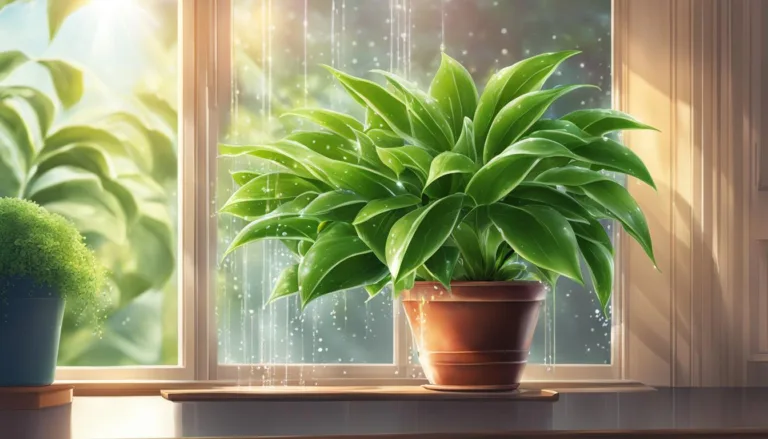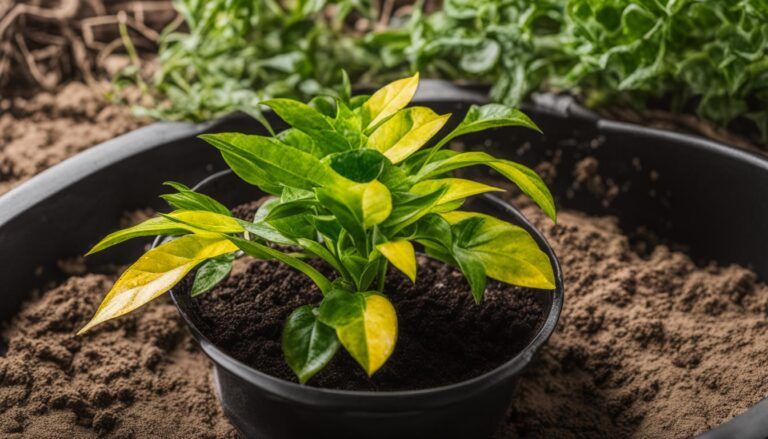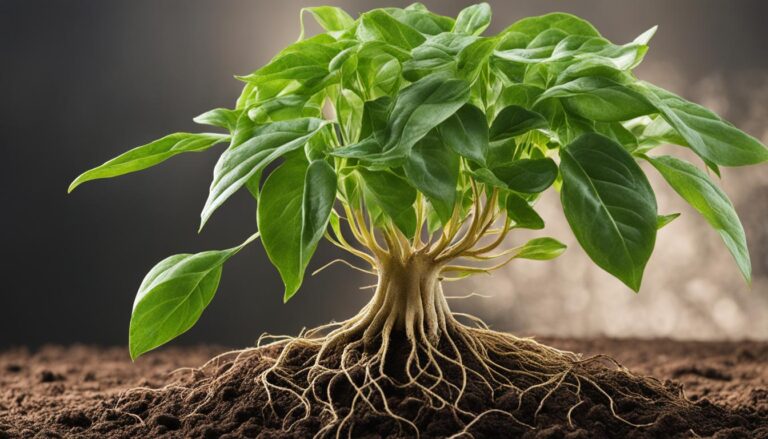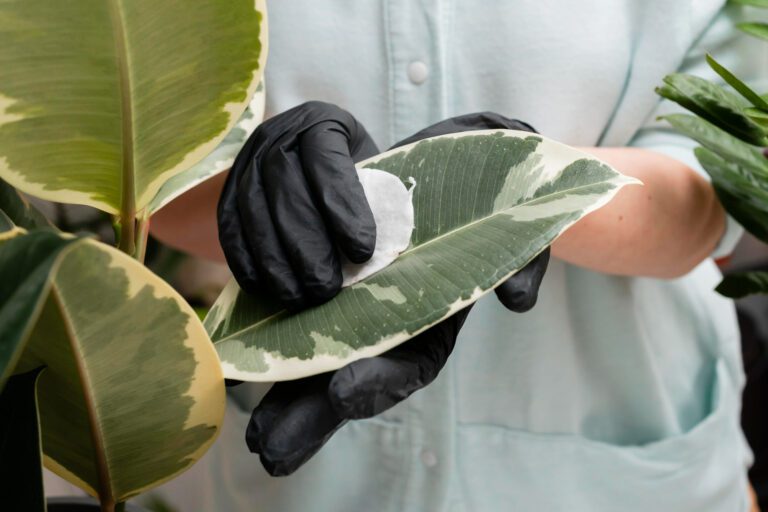
Disease resistance or tolerance in plants refers to their ability to withstand or overcome the impact of pathogens to some extent. While it doesn’t guarantee complete immunity, using disease-resistant varieties can significantly reduce the need for pesticides and help control plant diseases.
Different plants have varying levels of resistance or tolerance to specific diseases. For example, some varieties of monarda, phlox, rose, zinnia, apple, asparagus, beans, broccoli, cucumber, pea, pepper, sweet corn, and tomato have resistance or tolerance to various diseases such as powdery mildew, black spot, verticillium wilt, and more.
Key Takeaways:
- Using disease-resistant indoor plants helps reduce the risk of plant diseases and promote plant health.
- Selecting disease-resistant varieties suitable for your indoor environment is crucial for disease prevention.
- Proper plant care, including watering, lighting, and nutrition, plays a vital role in promoting disease resistance.
- Implementing cultural practices such as sanitation, rotation, and proper ventilation helps prevent and manage diseases.
- Regular monitoring and early intervention are essential for detecting and preventing diseases in indoor plants.
Benefits of Disease Resistance in Indoor Plants
Using disease-resistant indoor plants offers several benefits. Firstly, it reduces the risk of plant diseases, ensuring the longevity and health of your indoor plants. Disease-resistant plants are more likely to thrive and require fewer interventions to prevent or treat diseases.
This means less time and effort spent on disease management, allowing you to enjoy your indoor garden without constant worries.
Secondly, promoting plant resistance through the use of resistant varieties or cultivating healthy plants helps maintain a balanced ecosystem within your indoor space. By minimizing the use of pesticides and other interventions, you can create a healthier environment for both your plants and yourself.
Indoor plants not only add beauty and tranquility to your space but also contribute to cleaner air quality. Disease-resistant plants contribute to this by requiring fewer pesticides, which can be harmful to both humans and the environment.
Furthermore, disease-resistant indoor plants can save you money in the long run. With reduced requirements for chemical treatments and interventions, you can save on the cost of pesticides and other disease management products.
Also, disease-resistant plants are more likely to have a longer lifespan, meaning you won’t have to replace them as frequently. This can result in significant savings over time, making disease-resistant indoor plants a wise investment.
Promoting Plant Resistance for Sustainable Indoor Gardening
Overall, disease-resistant indoor plants bring numerous advantages. They minimize the risk of plant diseases, promote a healthier indoor environment, and offer long-term cost savings.
By incorporating disease-resistant varieties into your indoor garden and practicing proper plant care and management strategies, you can maintain beautiful, vibrant, and disease-free plants, enhancing the overall enjoyment and wellbeing of your indoor space.
| Advantages of Disease-Resistant Indoor Plants |
|---|
| Reduced risk of plant diseases |
| Less need for chemical interventions |
| Enhanced indoor ecosystem balance |
| Improved air quality |
| Cost savings on pesticides and replacements |
Plant Health Strategies to Prevent Diseases in Indoor Plants
Ensuring the health of indoor plants is key to preventing diseases and maintaining their overall well-being. By implementing effective plant health strategies, you can create an environment that promotes disease resistance and minimizes the risk of infections. Here are some essential practices to consider:
- Select disease-resistant varieties: Start by choosing indoor plants that are naturally resistant to common diseases. Research and identify varieties that have proven resistance or tolerance to specific pathogens.
- Provide proper environmental conditions: Indoor plants thrive in specific lighting, humidity, and temperature conditions. Ensure your plants receive adequate light, maintain optimal humidity levels, and avoid extreme temperature fluctuations.
- Maintain good hygiene: Regularly clean your plant’s leaves and containers to remove dust, debris, and potential pathogens. Prevent the buildup of moisture by avoiding overwatering and providing proper drainage.
- Ensure adequate nutrition: Proper nutrition strengthens plant immunity and resistance to diseases. Use balanced fertilizers and provide essential nutrients to support healthy growth and development.
Promoting Disease Resistance Through Plant Health Strategies
Implementing these plant health strategies helps create an environment that fosters disease resistance in indoor plants. From selecting resistant varieties to maintaining optimal environmental conditions, each step contributes to the overall well-being and resilience of your plants.
In the next section, we will explore cultural practices that further enhance disease prevention and management in indoor plants.
Cultural Practices for Disease Prevention and Management
Disease prevention and management in indoor plants can be effectively achieved through the implementation of cultural practices. These practices focus on creating a healthy and disease-resistant environment for your plants. By incorporating the following strategies into your plant care routine, you can significantly reduce the risk of diseases and promote a thriving indoor garden.
Sanitation and Proper Hygiene
Proper sanitation practices are crucial in preventing the spread of diseases in indoor plants. Regularly clean and disinfect your gardening tools, pots, and containers to eliminate any potential pathogens. Remove and destroy any infected plant parts to prevent the disease from spreading further.
By maintaining cleanliness and practicing good hygiene, you create a less favorable environment for disease-causing organisms.
Proper Plant Spacing and Rotation
Overcrowded plants can create conditions that promote the spread of diseases. Providing adequate spacing between your indoor plants allows for better air circulation, reducing the chances of diseases taking hold.
Additionally, rotating your plants regularly helps prevent the buildup of pathogens in the soil. This practice interrupts the disease cycle and minimizes the risk of recurring infections.
Companion Planting
Companion planting involves growing different plant species together to create a mutually beneficial environment. Some plants naturally repel pests or inhibit the growth of disease-causing pathogens.
By strategically incorporating these companion plants into your indoor garden, you can reduce the risk of diseases and maintain a healthier environment for your plants.
| Cultural Practices | Benefits |
|---|---|
| Sanitation and Proper Hygiene | Prevents the spread of diseases |
| Proper Plant Spacing and Rotation | Reduces the risk of recurring infections |
| Companion Planting | Inhibits the growth of disease-causing pathogens |
Implementing cultural practices for disease prevention and management is an essential aspect of indoor plant care. By focusing on sanitation, proper plant spacing and rotation, and strategic companion planting, you can create a healthier and disease-resistant environment for your indoor plants.
These practices, when combined with other plant health strategies, contribute to the overall well-being and longevity of your indoor garden.
Integrated Pest Control for Indoor Plants
When it comes to maintaining healthy indoor plants, pest control plays a crucial role in preventing diseases and ensuring their overall well-being. Implementing an integrated approach to pest control can help you effectively manage pests while promoting disease prevention. By adopting a combination of strategies, you can create a pest-free environment for your indoor plants.
One of the first steps in integrated pest control is practicing proper plant hygiene. Regularly inspect your plants for any signs of pests and remove any infected or damaged plant parts.
This helps prevent the spread of pests and diseases to other healthy plants. Additionally, consider using physical barriers such as insect screens to keep pests from entering your indoor space.
Another strategy is to introduce natural predators or beneficial insects that can help control pest populations. Ladybugs, lacewings, and predatory mites are examples of beneficial insects that can keep common indoor plant pests, such as aphids and spider mites, in check.
Using organic pesticides or insecticidal soaps that are safe for indoor use can also be effective in controlling pests without harming your plants.
By adopting an integrated pest control approach, you can effectively prevent pests and diseases from affecting your indoor plants, ultimately contributing to their overall health and longevity. Regular monitoring, early intervention, and proper plant care are essential in maintaining a pest-free environment for your indoor plants.
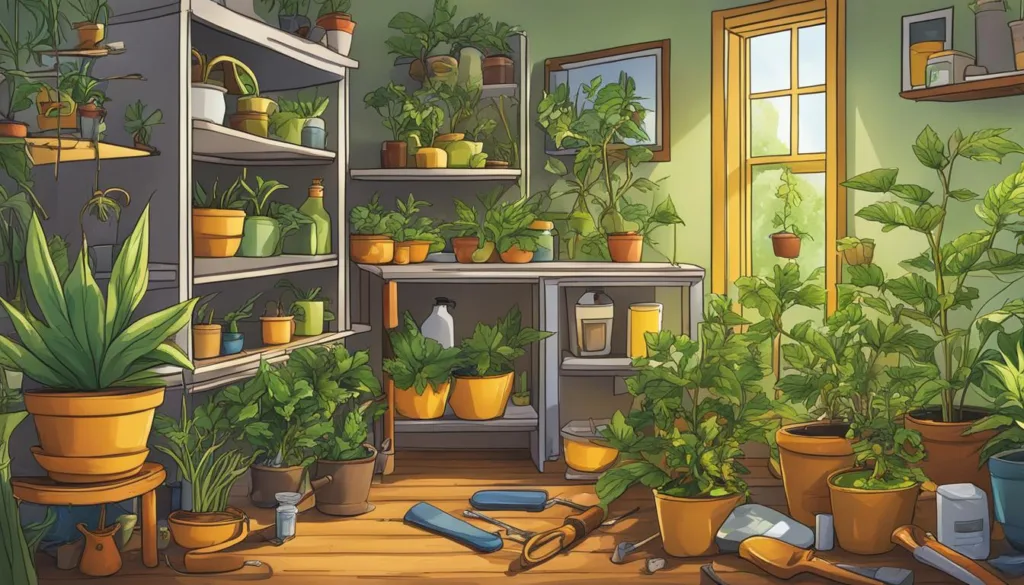
Common Indoor Plant Pests and Control Methods
| Pest | Control Methods |
|---|---|
| Aphids | Introduce ladybugs or lacewings, spray with insecticidal soap |
| Spider mites | Mist leaves with water to increase humidity, use predatory mites, spray with insecticidal soap |
| Mealybugs | Remove with cotton swabs dipped in rubbing alcohol, spray with insecticidal soap |
| Fungus gnats | Avoid overwatering, allow soil to dry between waterings, use sticky traps |
| Scale insects | Scrape off with a soft brush, spray with insecticidal soap |
Importance of Proper Plant Care for Disease Resistance
Proper plant care plays a crucial role in promoting disease resistance and maintaining healthy indoor plants. By following essential care practices, you can enhance the overall health and resilience of your plants, making them less susceptible to diseases.
Consistent watering is essential for plant health. Overwatering can lead to root rot and create a favorable environment for disease development. On the other hand, underwatering can weaken plants, making them more susceptible to infections. Therefore, it is important to find the right balance and water your plants appropriately.
Providing adequate light levels is another crucial aspect of plant care. Insufficient light can weaken plants and make them more vulnerable to diseases. Different plants have varying light requirements, so it is important to understand the needs of your specific indoor plants and ensure they receive the appropriate amount of light.
Proper nutrition is also key to promoting disease resistance. Ensure that your plants receive the necessary nutrients through suitable fertilization. Nutrient deficiencies can weaken plants and make them more susceptible to diseases.
Regularly inspecting plants for signs of stress, pests, or diseases, and taking immediate action, can prevent the spread of diseases and maintain a disease-free environment.
Key Factors for Promoting Disease Resistance in Indoor Plants
| Factor | Importance |
|---|---|
| Proper watering | Essential for plant health and disease resistance |
| Adequate light levels | Strengthens plants and reduces susceptibility to diseases |
| Proper nutrition | Enhances plant resistance to diseases |
| Regular inspection and action | Prevents the spread of diseases and maintains a disease-free environment |
By prioritizing proper plant care practices, you can create a healthy environment that promotes disease resistance in your indoor plants. Remember to provide adequate watering, suitable lighting, essential nutrition, and regular inspections to keep your plants thriving and disease-free.
The Role of Environmental Factors in Disease Management
The environment in which indoor plants are grown plays a crucial role in their overall health and disease resistance. By properly managing key environmental factors such as lighting, humidity levels, and temperature, you can promote plant resistance and maintain healthy indoor plants.
Lighting: Adequate lighting is essential for indoor plants to carry out photosynthesis, which is crucial for their overall growth and development. However, it’s important to strike the right balance, as too much or too little light can have adverse effects.
Different plants have varying light requirements, so it’s important to choose plants that are suitable for the available lighting conditions in your indoor space.
Humidity: High humidity levels can create a favorable environment for the development and spread of plant diseases. To prevent excessive humidity, ensure proper ventilation in your indoor space by opening windows, using fans, or installing dehumidifiers if necessary.
Consulting specific humidity requirements for your plants can help you maintain optimal conditions and reduce the risk of diseases.
Temperature: Fluctuations in temperature can weaken indoor plants and make them more susceptible to diseases. Avoid placing plants near drafty windows or heat sources that can cause sudden temperature changes.
Aim for stable temperatures that are suitable for the specific plants you are growing. Regularly monitoring and maintaining a consistent temperature range can significantly contribute to disease prevention and the overall health of your indoor plants.
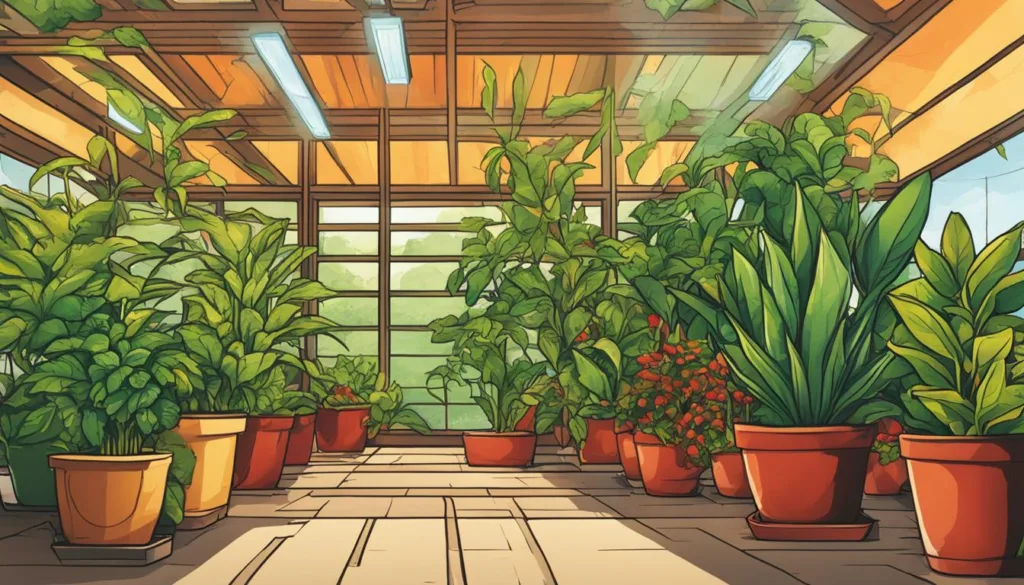
Environmental Factors and their Impact on Plant Health
| Environmental Factor | Impact on Plant Health |
|---|---|
| Lighting | Adequate light promotes photosynthesis and overall plant growth, while insufficient light can lead to weak plants. |
| Humidity | High humidity can create a favorable environment for plant diseases, while low humidity can cause leaf desiccation and stress. |
| Temperature | Temperature fluctuations can weaken plants and make them more susceptible to diseases and stress. |
By paying attention to these environmental factors and making adjustments as needed, you can create an optimal growing environment for indoor plants. This, in turn, promotes plant resistance, helps maintain healthy indoor plants, and reduces the risk of diseases.
Regular Monitoring and Early Intervention for Disease Prevention
Regular monitoring is crucial for maintaining the health of your indoor plants and preventing the spread of diseases. Keep a close eye on your plants and inspect them regularly for any signs of trouble.
Look for changes in appearance such as discoloration, spots, wilting, or deformities. Being vigilant allows you to detect diseases at their early stages, increasing the chances of successful intervention.
If you notice any signs of disease, it’s important to take immediate action. Isolate the infected plants to prevent the spread of pathogens to other healthy plants. Treat the affected plants promptly with appropriate control measures to stop the disease from progressing.
Early intervention is key to preventing diseases from spreading and maintaining a disease-free environment for your indoor plants.
By regularly monitoring your plants and intervening early, you can effectively prevent and manage diseases in your indoor garden. This proactive approach not only helps in disease prevention but also ensures the overall health and well-being of your plants.
Remember to stay observant, take swift action, and provide the necessary care to keep your indoor plants thriving and disease-free.
FAQ
What are disease resistance strategies for indoor plants?
Disease resistance strategies for indoor plants include using disease-resistant varieties, proper site selection and maintenance, implementing cultural practices, integrated pest control, and regular monitoring and early intervention.
What are the benefits of disease resistance in indoor plants?
Disease-resistant indoor plants reduce the risk of plant diseases, promote plant resistance, require fewer interventions, and create a healthier indoor environment.
What are plant health strategies to prevent diseases in indoor plants?
Plant health strategies for indoor plants include selecting disease-resistant varieties, maintaining suitable lighting, humidity, and temperature conditions, practicing good hygiene, avoiding overwatering, and providing adequate nutrition.
What are cultural practices for disease prevention and management in indoor plants?
Cultural practices for indoor plant disease prevention and management include proper sanitation, rotating plants, avoiding overcrowding, companion planting, and providing adequate air circulation and ventilation.
How can integrated pest control help prevent diseases in indoor plants?
Integrated pest control for indoor plants involves using multiple strategies to prevent and manage pests, indirectly helping prevent diseases. This includes practicing proper plant hygiene, using physical barriers, employing natural predators or beneficial insects, and using organic pesticides or insecticidal soaps if necessary.
Why is proper plant care important for disease resistance in indoor plants?
Proper plant care, including consistent watering, suitable light levels, and proper nutrition, is essential for promoting disease resistance in indoor plants. It helps maintain overall plant health and resilience, preventing plants from becoming susceptible to diseases.
What role do environmental factors play in disease management for indoor plants?
Environmental factors such as lighting, humidity levels, and temperature significantly impact plant health and reduce the risk of diseases. Proper management of these factors ensures a stable and suitable environment for indoor plants, promoting disease resistance.
How important is regular monitoring and early intervention for disease prevention in indoor plants?
Regular monitoring of indoor plants is essential for early disease detection and prevention. By inspecting plants frequently and taking immediate action if any signs of disease are observed, you can isolate infected plants, treat them promptly, and maintain a disease-free environment for your indoor plants.

